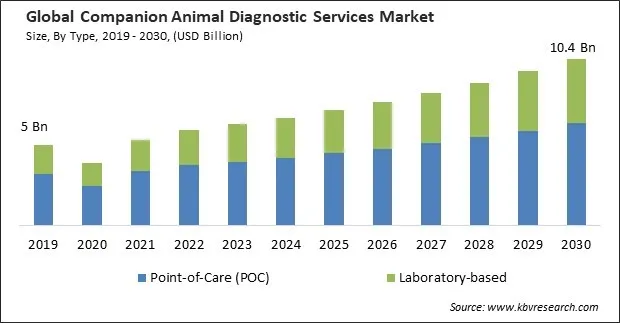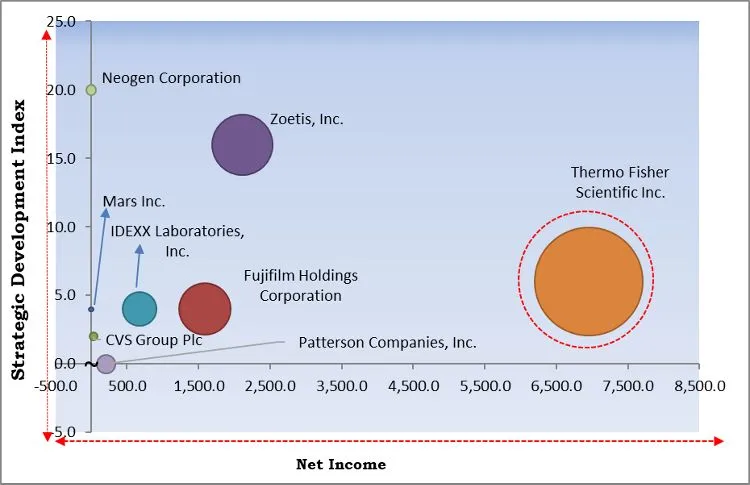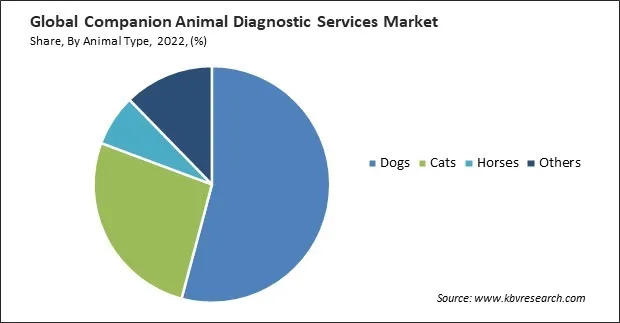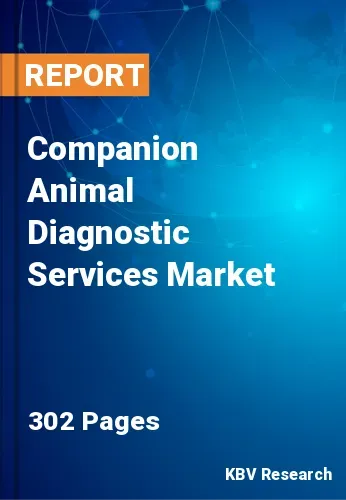The Global Companion Animal Diagnostic Services Market size is expected to reach $10.4 billion by 2030, rising at a market growth of 7.4% CAGR during the forecast period.
Cytopathology is performed in real-time during procedures. This immediate feedback aids veterinarians in making on-the-spot decisions about patient care. Thus, the cytopathology segment garnered $342.6 million revenue in the market in 2022. Cytopathology provides rapid results, often within minutes to hours, allowing veterinarians to diagnose and initiate treatment for companion animals quickly. This is particularly valuable in emergency cases and when prompt decisions are essential.

The major strategies followed by the market participants are Acquisitions as the key developmental strategy to keep pace with the changing demands of end users. For instance, In June, 2023, Mars, Inc. completed the acquisition of Heska Corporation. With this acquisition, Mars would achieve wider coverage across diagnostics and technology, better R&D and access to pet healthcare solutions. Additionally, In September, 2022, Zoetis Inc. completed the acquisition of Jurox Pty Limited, an Australian veterinary pharmaceutical manufacturer. Through this acquisition, Zoetis achieved greater worldwide expansion and the manufacture of an anaesthetic product for companion animals called Alfaxan.
Based on the Analysis presented in the KBV Cardinal matrix; Thermo Fisher Scientific Inc. is the forerunner in the Market. Companies such as Zoetis, Inc., Fujifilm Holdings Corporation, IDEXX Laboratories, Inc. are some of the key innovators in Market. In December, 2022, Fujifilm Holdings Corporation acquired Inspirata, Inc., to merge pathology images and data into the electronic health record system of the healthcare organizations. Additionally, the acquisition helped to simplify care designated for oncology patients.

Ongoing advancements in diagnostic technologies, such as digital radiography, ultrasound, genetic testing, and PCR assays, have improved the accuracy and range of pet diagnostic services. Digital X-ray technology has largely replaced traditional film-based radiography. It provides clearer and faster imaging, reduces radiation exposure for animals and staff, and allows for easy sharing of images with specialists for remote consultation. Ultrasound technology has advanced, offering higher resolution and better detail for imaging soft tissues and organs. CT and MRI scans provide three-dimensional images with exceptional clarity, aiding in diagnosing complex conditions such as neurological disorders, tumors, and musculoskeletal injuries. These advancements in diagnostic technologies have enhanced the quality of care for companion animals and expanded the range of services that veterinary clinics offer. As technology evolves, diagnostic capabilities will likely become even more advanced, contributing to further improvements in market.
Pet owners are becoming increasingly conscious of the significance of preventive care and early disease detection in their animals. This awareness drives them to seek diagnostic services for their pets. Pet owners who know the importance of regular checkups and vaccinations are more likely to schedule routine visits to veterinary clinics. These visits often include diagnostic tests as part of the wellness examination. Knowledgeable pet owners understand that early detection of diseases can lead to more effective treatments and better outcomes for their pets. They are more likely to request diagnostic tests and screenings for common health issues. These approaches often involve diagnostic tests to guide treatment plans. The rising awareness of pet health benefits the market and improves pet longevity and well-being. As this awareness grows, the demand for diagnostic services will likely remain strong, further driving advancements in market.
The cost of certain diagnostic tests and procedures is prohibitive for some pet owners, especially those with limited financial resources. This can lead to delays in seeking necessary veterinary care and diagnostics. High diagnostic costs discourage pet owners from investing in preventive care, including regular checkups and screenings. This can result in missed opportunities for early disease detection and intervention. In rural or underserved areas, where veterinary services are less abundant, the cost of diagnostics can be a significant barrier to pet healthcare. Pet owners need to travel long distances to access affordable services. Therefore, the high costs of diagnostic services pose a significant challenge to the market.
Based on type, the services market is classified into point-of-care (POC) and laboratory-based. In 2022, the point-of-care (POC) segment witnessed the largest revenue share in the market. The POC segment aligns with telemedicine platforms, allowing veterinarians to consult remotely with pet owners while using POC diagnostics to assess an animal’s health condition. POC diagnostics aid in surveilling zoonotic diseases by quickly identifying potential cases in companion animals, thus contributing to public health efforts. The growth of the POC segment is driven by the increasing demand for convenient, rapid, on-site diagnostic solutions in companion animal healthcare.

On the basis of animal type, the market is divided into dogs, cats, horses, and others. The cats segment recorded a remarkable revenue share in the market in 2022. Cats are living longer, and the senior cat population is growing. This age group requires more frequent diagnostic assessments to manage age-related health concerns like kidney disease and arthritis. Diagnostic tests for parasites like intestinal worms and heartworms are essential for the health of cats. As the cat population increases, so does the demand for preventive diagnostic services.
By testing category, the market is categorized into clinical chemistry, microbiology, parasitology, histopathology, cytopathology, hematology, immunology & serology, imaging, molecular diagnostics, and others. In 2022, the clinical chemistry segment held the highest revenue share in the market. Clinical chemistry tests are routinely used to assess companion animals' overall health and well-being. They provide baseline data veterinarians use to monitor an animal's health over time. Clinical chemistry tests can detect the presence of various diseases and health conditions in companion animals.
| Report Attribute | Details |
|---|---|
| Market size value in 2022 | USD 5.9 Billion |
| Market size forecast in 2030 | USD 10.4 Billion |
| Base Year | 2022 |
| Historical Period | 2019 to 2021 |
| Forecast Period | 2023 to 2030 |
| Revenue Growth Rate | CAGR of 7.4% from 2023 to 2030 |
| Number of Pages | 302 |
| Number of Table | 423 |
| Report coverage | Market Trends, Revenue Estimation and Forecast, Segmentation Analysis, Regional and Country Breakdown, Competitive Landscape, Companies Strategic Developments, Company Profiling |
| Segments covered | Type, Animal Type, Testing Category, Region |
| Country scope | US, Canada, Mexico, Germany, UK, France, Russia, Spain, Italy, China, Japan, India, South Korea, Singapore, Malaysia, Brazil, Argentina, UAE, Saudi Arabia, South Africa, Nigeria |
| Growth Drivers |
|
| Restraints |
|
Region-wise, the market is analysed across North America, Europe, Asia Pacific, and LAMEA. In 2022, North America led the market by generating the highest revenue share. North America has one of the largest markets globally. The market continues to grow due to increasing pet ownership, rising awareness of pet health, advancements in diagnostic technologies, and a growing emphasis on preventive healthcare for pets. Veterinary clinics and hospitals across North America offer various diagnostic services, including blood tests, urinalysis, radiology, ultrasonography, and endoscopy. These facilities provide comprehensive care for companion animals. North America boasts a robust and growing market, driven by pet ownership trends, advanced healthcare practices, and a strong emphasis on pet health and well-being. This region remains at the forefront of veterinary diagnostics innovation and adoption.
Free Valuable Insights: Global Companion Animal Diagnostic Services Market size to reach USD 10.4 Billion by 2030
The market research report covers the analysis of key stake holders of the market. Key companies profiled in the report include Zoetis, Inc., IDEXX Laboratories, Inc., Mars Inc., Fujifilm Holdings Corporation, Embark Veterinary, Inc., Thermo Fisher Scientific Inc., Patterson Companies, Inc., Randox Laboratories Limited, CVS Group Plc, and Neogen Corporation
By Type
By Animal Type
By Testing Category
By Geography


This Market size is expected to reach $10.4 billion by 2030.
Advancements in diagnostic technologies are driving the Market in coming years, High cost of diagnostic services restraints the growth of the Market.
Zoetis, Inc., IDEXX Laboratories, Inc., Mars Inc., Fujifilm Holdings Corporation, Embark Veterinary, Inc., Thermo Fisher Scientific Inc., Patterson Companies, Inc., Randox Laboratories Limited, CVS Group Plc, and Neogen Corporation
The expected CAGR of this Market is 7.4% from 2023 to 2030.
The Dogs segment is leading the Market by Animal Type in 2022; thereby, achieving a market value of $5.4 billion by 2030.
The North America region dominated the Market by Region in 2022; thereby, achieving a market value of $3.7 billion by 2030.
Our team of dedicated experts can provide you with attractive expansion opportunities for your business.

